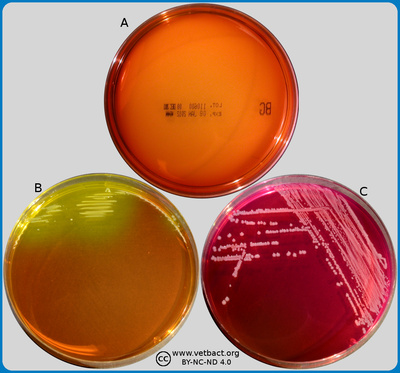Brilliant Green (BG) agarThe figure shows three BG agar plates. Bacteria were not cultivated on the plate in image A. On the plate in image B, Escherichia coli has been cultivated. Note that the colour of this plate has changed from yellowish-red to yellow where colonies appear and, therfore, the colonies appear as yellowish. Salmonella sp. has been cultivated on plate C. Note that the colour of this plate has changed from yellowish-red to dark red and that the colonies are pink. E. coli does only grow poorly on BG agar. - Click on the image to enlarge it. Image: Karl-Erik Johansson (BVF, SLU) and Lise-Lotte Fernström (BVF, SLU).
ApplicationsBrilliant Green (BG) Agar is used for selective isolation of Salmonella spp. Content of the medium:
The enzymatic digests provide sources of nitrogen, amino acids and carbon. The yeast extract supplies vitamins required for growth of bacteria. NaCl maintains the osmotic balance of the medium. Lactose and sucrose are the carbohydrates in the medium. Brilliant green (BG) inhibits gram-positive bacteria and most gram-negative rods other than Salmonella spp. The pH is 6.9. Phenol red is the pH indicator, which turns the yellow upon acidification due to fermentation of lactose and/or sucrose. Agar is the solidifying agent. Other comments:
Updated: 2024-03-17. |

